Formula One - 1990 Japanese and Australian Grands Prix
Far Eastern Fantasy
The worldwide Formula One Championship took the travelling ‘circus’ to Japan on October 21st, to the medium fast interesting Suzuka circuit with its unusual figure of eight layout with a flyover in the middle, and then south to the Adelaide street circuit in Australia on November 4th, there to wind up the 1990 season of sixteen races. The Australian Grand Prix was the 500th event to count for the FIA World Championship for Drivers, not the 500th Grand Prix race, nor even the 500th World Championship Grand Prix race, as so much of the media quoted. It was hoped that the Championship would be settled between Senna and Prost with a stirring race to the end in the Australian Grand Prix, or at least an exciting finale in Japan to keep Honda happy.
But it was not to be, for exactly 9.2 seconds after the start of the Japanese Grand Prix Prost and Senna collided and the FIA’s ‘sacred’ World Championship ended in a cloud of dust as the Ferrari and the McLaren spun off across the wide run-off area of the first corner. While the marshals cleared the wreckage out of the way Senna walked back to the pits as the 1990 World Champion, and Prost prepared a whingeing campaign that was to continue for two weeks.
If you have always viewed the World Championship as a bit of a farce, or at least since 1958 when Stirling Moss was not World Champion as I have, this unhappy ending to the 1990 Championship was about par for the course.
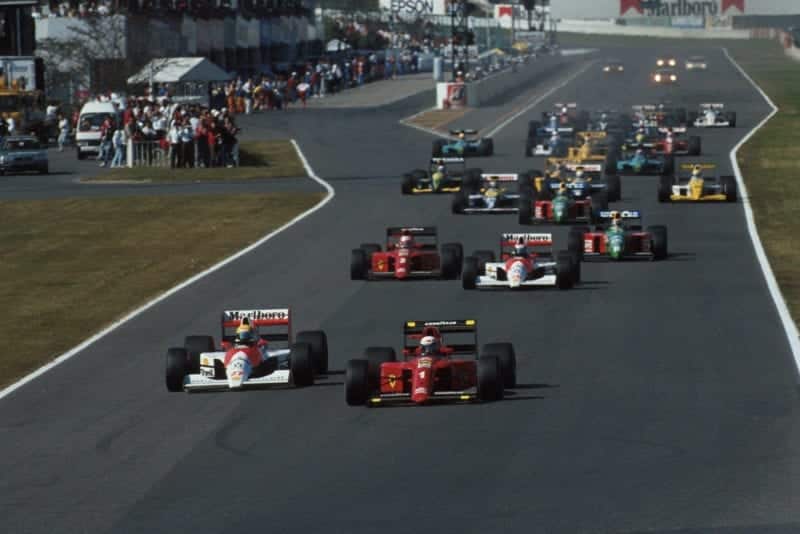
Alain Prost and Ayrton Senna moments before their championship-deciding crash
Motorsport Images
Since October 21st when ‘the world and his wife’ saw what they thought happened in those critical 9.2 seconds on television they have been joined by ‘every man and his dog’ in taking sides, explaining what happened, making judgement on both drivers and banging on about the rights and wrongs of the incident which appeared to be a motor racing accident that was all over in a few seconds, as was the Japanese Grand Prix for the media and the casual spectator.
For more serious people whose interest is the actual race, the disappearance of the two best drivers in Grand Prix racing on the first lap left the race open for a lot of other drivers and teams. When Gerhard Berger threw it all away on lap 2, while leading into ‘World Champions Corner’ the race really was wide open. Berger just went too fast into the corner which was still a bit slippery from dust thrown up on lap 1.
Stefano Modena had spun off on lap 1 in the general melée after the start, so the field was getting a bit thin before the race got into its stride as there had only been 25 cars on the grid anyway. Jean Alesi missed the race altogether as an excursion off the track during Friday practice had strained his neck muscles and caused him to miss the whole of Saturday’s practice and qualifying. He tried again in the race-morning ‘warm up’ but the pain was more than he could stand, so he was withdrawn by Team Tyrrell. There had been quite a lot of reshuffling of the Grand Prix cast before practice began at Suzuka, for Martin Donnelly was still in hospital, recovering slowly from his big accident at Jerez, and Alessandro Nannini was very much on the sick list after a very bad accident in a helicopter. The number two car at Lotus was taken over by Johnny Herbert, and the number two Benetton by Roberto Moreno, the quiet Brazilian, with a lot of experience behind him, but not much fortune in Formula One. His regular drive with the EuroBrun team had just fizzled out, as the Swiss/Italian team had pulled out of the World Championship for these last two races, as had the Life team, so Moreno was in luck for once, and joined his friend and mentor Nelson Piquet in the Benetton/Ford backed team.
With Senna, Prost and Berger throwing away their chances of winning the Japanese Grand Prix it was an easy job for Mansell to take command, which he did with authority. However, he could not relax as behind him were the two Benettons, settled in to make a non-stop run whereas Mansell was scheduled to make a pitstop for tyres half way through the race. This question of tyre stop or nonstop running has been an interesting part of the 1990 season, particularly on medium-speed circuits. The Cosworth V8 EXP works engine in the Benetton cars is quite a lot down on the power available from Honda, Ferrari and Renault engines, but it is all a question of how you use the power available to you. If your chassis and suspension needs a lot of downforce created aerodynamically and you have a surplus of power then you can overcome the drag caused by aerofoils. If your chassis and suspension are good you can run with less downforce, and if your engine has less power than the others, you can compromise to attain equality. With lap speeds around 120mph it is just possible for a car like the Benetton to keep the leaders in sight and run through nonstop with less downforce on the tyres encouraging less wear. On a circuit with lap speeds around 150mph this does not apply, the more powerful cars getting too far ahead, even with more downforce, and having enough lead to make a pitstop for new tyres without being caught.
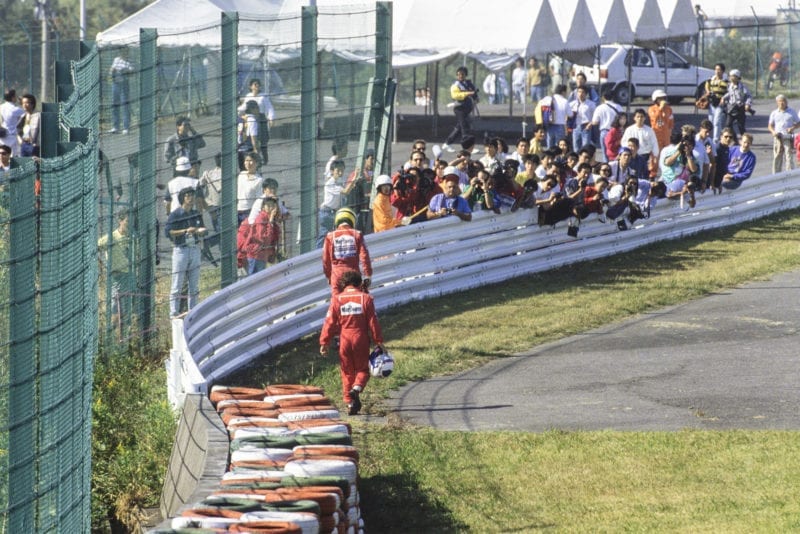
Senna and Prost walk away from their crash, the Brazilian the 1990 champion
Motorsport Images
Suzuka is a Benetton-type circuit, and also a Tyrrell, Leyton House, Minardi. Ligier, Arrows and Brabham type as well in theory, except that there are a lot of other ingredients required to do what Benetton do, with Mansell leading the race comfortably, but conscious of his forthcoming pitstop, Piquet settled into a steady pace that kept the Ferrari driver on his toes. This in itself was not so remarkable because Piquet should never be underestimated; after all, he has won three World Championships, a lot of races, and has always been a ‘crafty racer’ with a lot of trackcraft. The real surprise was that Roberto Moreno was following Piquet’s every move, literally running in his wheel tracks and looking very comfortable and confident. It tended to make you forget that there were a lot of ‘famous’ drivers behind him, Boutsen, Patrese, Warwick, Nakajima, Bernard and Capelli for example.
In qualifying, and on the grid therefore, Piquet had split the two Williams-Renault drivers, and Moreno was just behind them. In fact, Moreno was half a second slower than Piquet, which was an impressive debut for the quiet Brazilian in his first time in a ‘halfway decent car’. Right from the start of the race he had followed Piquet through and was very happily ensconced in his wake.
On lap 27 Mansell was into the pit lane for his scheduled tyre stop, which went quickly enough, and he took off with a blue smoke haze from his new rear tyres as he headed down the pit lane for the exit. He didn’t reach it! An output shaft from the transmission sheared under the load and a frustrated Nigel Mansell coasted to a stop and out of the race.
A smiling Piquet inherited the lead with his friend following dutifully into second place. Impressively Nelson Piquet settled into a regular pace that suited Moreno and led the way to victory for the Benetton team. Meanwhile there were a lot of teams and drivers following along behind wondering what they had done wrong, especially as in third place was the Japanese driver Aguri Suzuki in a Lola-Lamborghini V12 of the Larrousse team which was running like clockwork.
When Nelson Piquet got the chequered flag, followed by Moreno, he slowed up and let his team-mate draw alongside and the sight of the two Benettons on their slowing-down lap running in close team formation was an emotional occasion which put some sense into the turmoil going on behind the scenes in the paddock over the first lap shambles. The emotions of the two Brazilians when they got out of the cars just overflowed and the photograph published in Autosport in their issue of 25th October, of Piquet and Moreno hugging each other says it all, and gets my vote for ‘The Photograph of the Year’. At the post-race ‘press conference’ at which the first three drivers in the race talk to the media, Nelson Piquet put the finishing touch to a very happy occasion when he arrived and said ‘Good afternoon, you may not remember me, my name is Nelson Piquet’.
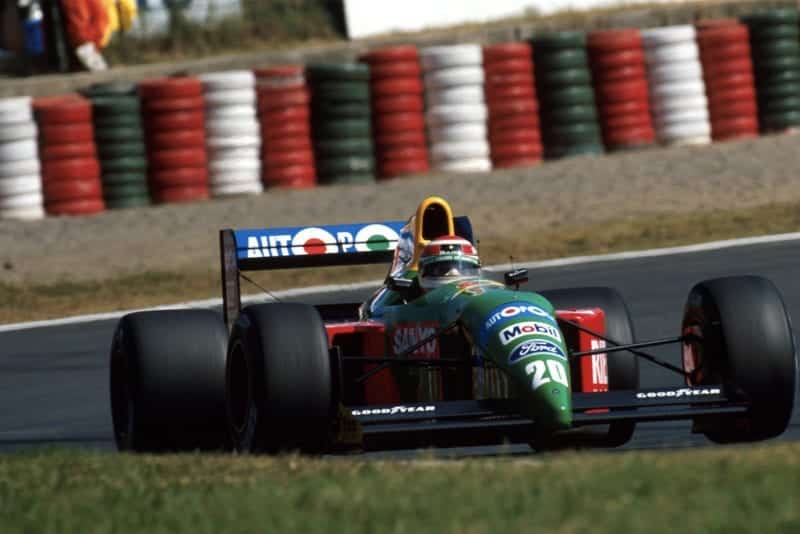
Nelson Piquet leading in the Benetton
Motorsport Images
By November 1st the ‘circus’ was set up once more, this time in Australia, on the Adelaide street circuit, the ‘movements plans’ and transportation of about 2000 people and all the cars and materials and equipment being one of the wonders of the modern racing scene and a tribute to all those who work away behind the scenes to make it all happen. Before the racing engines were started up there was a lot of talking about the rights and wrongs of the world of Formula One, much of it doing nobody any good and a lot of it just stirring up more hatred, bitterness and controversy which seems to be the lifeblood of the daily paper, television and media world. ‘Negative is news, positive is boring’ seems to be the motto of the media, and presumably the people who read it.
If there was time to reflect on the happenings in Japan they should have been on the good things, though some were brought about by sadness. Nannini’s unfortunate helicopter accident looks like putting him out of racing for a long time, maybe forever from Formula One, as the chances of his arm injury mending to be strong enough for Grand Prix driving look pretty slim. Donnelly’s recuperation looks like being a long process, and spare a thought for Regazzoni and Philippe Streiff who are still with us, but can never race again because of the injuries that racing caused them. These sadnesses have meant that someone has had to take their places, and in Japan we saw Roberto Moreno do everything that was expected of him when he took Nannini’s place in the Benetton team. Moreno has always puzzled me, ever since he was given a chance to drive a works Lotus way back in 1982. I watched him then as he failed to qualify for the Dutch Grand Prix and could never really convince myself as to why, other than perhaps he was thrown in at the deep end before he had learnt to do a strong ‘overarm’ and in Formula One there is no room for the ‘breast stroke’. He never disappeared for very long, always racing something, somewhere and even when he wasn’t racing, or had failed to qualify some rather hopeless Formula One car, you would see him in the pits or paddock watching the top people at work, with a look of envy on his face, not one of bitterness thinking ‘I could do what he is doing’, but a genuine look of ‘I would love to be there’. Pushy is a word that I am sure does not enter into the Moreno vocabulary, which is why I have had a soft spot for him for many years, but always with a touch of sadness, so my joy at his performance in Japan was nearly as much as his own. It is odd, but I have always had this same feeling about Emerson Fiftipaldi since he bowed out of Formula One, so that when I heard he had won the Indianapolis 500 Mile race I gave a loud cheer of ‘Good old Emmo’.
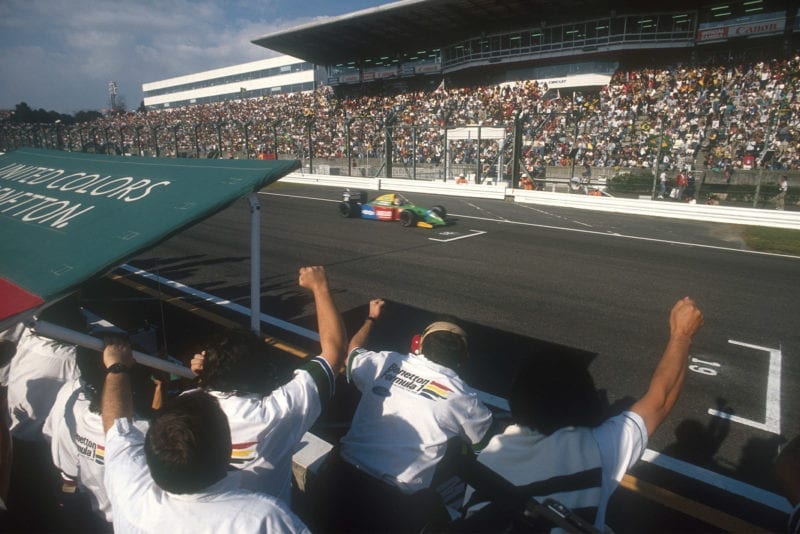
Piquet crosses the line and wins to the delight of his Benetton team
Motorsport Images
I have always been a Piquet fan, and during his disastrous two seasons with Lotus I could not bring myself to get too close, but merely watched from afar. He always made it clear that he was not going to ‘bust his gut’ to drag a Lotus from 16th place up to 14th place. If there was the slightest hope of getting into the first six, then he would rise to the occasion. His detractors would say ‘Oh yes, and if the occasion arises he will have forgotten how to do it’ but Brian Hart, another Piquet fan, used to say to me ‘People tend to forget that Piquet has won a lot of races, and been World Champion three times if you rate that sort of thing’. This past season we have seen Piquet keeping his promise about a chance of getting in the first six, and some of his performances in the Benetton have been very good. Even he knows he is no longer in the Senna and Prost class, but he is still near the top, and though his win in Japan was occasioned by a certain amount of good fortune, if he hadn’t been in second place behind Mansell when the Ferrari broke, someone else could have won. While Japan was a joyday for Piquet fans, little did we imagine what was going to happen in Australia.
What was certain was that the Australian Grand Prix had little to do with the Drivers World Championship, it was a Grand Prix standing on its own merit on a circuit that most people seem to enjoy, and in an ambience that makes a fitting end to a season, even if there is a very long journey home afterwards for most people. What was equally evident was that Ayrton Senna approached it as he does every race, to be on pole position on the grid and to win the race, preferably leading from start to finish. Equally evident was that Alain Prost was taking his World Championship defeat rather badly, taking over the title of whinger of the year from Nigel Mansell by a country mile. This season ‘Our Nige’ has almost been ‘the sunshine boy’ and won the hearts of a lot of British mums and dads by announcing his retirement after the British Grand Prix last July, to spend more time with his family. When he signed a contract to drive for Williams-Renault in 1991 one began to wonder…At least we now know that we don’t have to take too much notice of anything Nigel Mansell says in future, not that some of us ever did.
This race was going to be a ‘last’ for a lot of people. It was Mansell’s last drive for Ferrari before moving to Williams, it was Boutsen’s last drive for Williams before he moves to Ligier, it was Alliot’s last drive for Ligier before he moves to Peugeot, it was Warwick’s last drive for Lotus before he moves to Jaguar sports cars, it was Modena’s last drive for Brabham before he moves to Ken Tyrell’s team, it was Alesi’s last drive for Tyrrell before he moves to Ferrari to join Alain Prost and all the way down the list there seems to be moves pending.
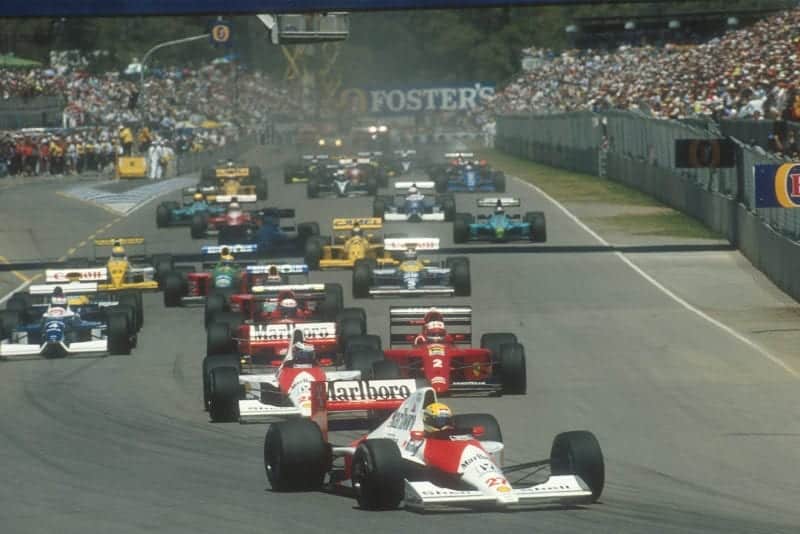
Ayrton Senna leads the start of the final round of the season
Motorsport Images
Even a lot of teams were having their ‘last event’ moving either into obscurity or to better things and even into pastures new. McLaren were having their last race with the Honda V10 engine, the new V12 already being tested, Tyrrell were about to abandon Cosworth engines in favour of the Honda V10, Larrousse were having the last use of the Lamborghini V12 engine into which they have put so much effort, being forced to turn to Cosworth power, and Lotus were also having their last use of the Italian V12 engines through no choice of their own. The Leyton House team were hoping it would be their last race with the Judd V8 and that the Chevrolet Ilmor engine would soon be appearing, and Brabham were also pulling out of using Judd engines, now that Yamaha had revealed their V12 engine for 1991.
There were so many changes imminent, and many more in the planning that you felt like putting all the variables into a pot, stirring them thoroughly over a low heat and then ladling out a portion to each aspiring team for 1991. If you did this you would probably get the same answer as in 1990. Up at the front would be McLaren, Ferrari and Williams; nibbling at their tails would be Tyrrell, Benetton and possibly Leyton House, with one or two interesting prospects in the offering, and most of the teams who have been down the back all this season would probably still be there. On the driver front Senna, Prost, Mansell, Berger and Alesi will be to the fore, with Piquet in there somewhere and Capelli, Gugelmin, Suzuki, Patrese, Martini and Nakajima forming a fairly strong chorus.
But how about the Australian GP? There was nothing to lose for anyone, much to enjoy and the sun was shining. Qualifying had seen Senna as dominant as ever, scoring his 52nd pole position and Berger was in front of both Ferraris. Almost alongside Prost was Alesi with the Hart-powered Tyrrell 019, which makes you wonder where he will be next year when he is in a Ferrari. Then came the two Benettons, still on a ‘high’ after their wonderful time in Japan, and this time Moreno was less than half a second behind Piquet. As he said, ‘learning is easy for me, with Piquet to teach me’. They were intermingled with the two Williams-Renaults, which did not look good either for Williams or for Renault, but it could be different next year when Mansell rejoins the team.
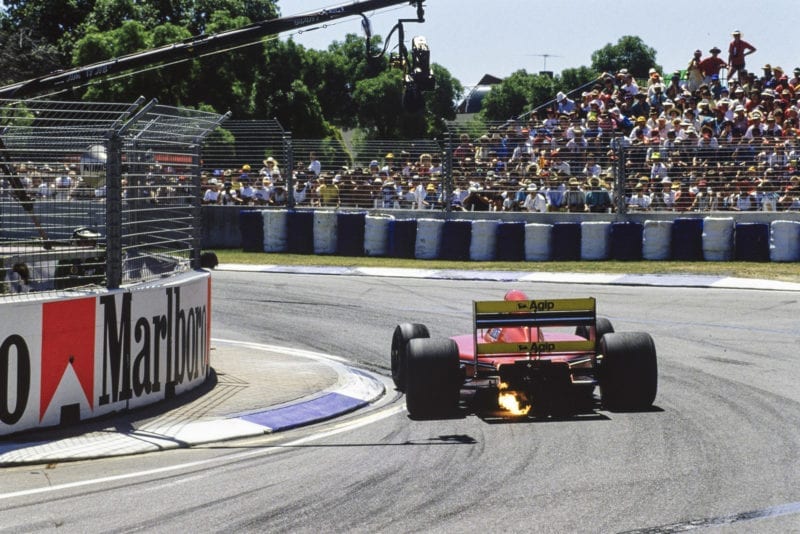
Nigel Mansell in his Ferrari
Motorsport Images
Prost had clearly given up, as he does too often, and Senna ran away from everyone from the green light. Mansell ousted Berger from second place on lap 2 and on lap 9 Piquet got past the Austrian, but Prost stayed back in 5th place, no doubt ‘whingeing’ quietly to himself and not concentrating on the job in hand. With Piquet up near the front and racing hard, no one in their right mind could expect Moreno to stay with him, but the second Benetton was running a good 9th, ahead of Warwick who was ‘best of the rest’.
While tyre wear was not critical in this race, brakes were, though it was more a question of brake temperature and cooling than simple pad wear. There are places on the circuit where brakes have to be used very hard before a corner, thus generating a lot of heat, and then have to be used really hard again before the initial heat has dissipated, so that a heat build-up can begin if a driver does not play it carefully, and fading brakes can be the result. When this happens you cannot guarantee that the brakes will pull evenly on all four wheels and a number of drivers were suffering this problem, even Senna out in front. While Mansell was securely in second place, he could not make any inroads on Senna’s lead and when the Ferrari had a spin into an escape road it seemed second place was gone, but Mansell gathered it all up and was back into the race before Piquet appeared.
The Ferrari had worn flats on the tyres as it spun and Mansell wanted to head straight for the pits and a new set at the end of that lap, but his team told him over the radio phone to stay out for a bit as they hadn’t got a new set warmed up properly in the portable oven. Whether to change onto ‘cold’ tyres or to delay for a couple of laps while they are ‘warmed’ is one of those moot points that a driver/team manager pairing has to make on the spur of the moment. It really is a case of ‘six of one and half a dozen of the other’. By the time Mansell was back in the race on new tyres he was down to 5th place, the order now being Senna, giving a good demonstration of why he is World Champion Grand Prix driver, the crafty Piquet in second place, driving with all his long-accumulated craft, Berger in third place, and Prost fourth. The call Mansell The Lion, but in motor racing parlance he should be called The Tiger, because `to tiger’ means to give it all you’ve got and a little more, but not so much that you have an accident.
There was little hope of catching Senna, but second place was rightfully Mansell’s and he was out to retrieve it. This situation woke up Prost who responded with laps in the low 1 min 20 secs and even into the 1 min 19 sec bracket, whereas he had been cruising round in the 1 min 21 sec and 1 min 22 sec bracket, and he passed Berger and took third place.
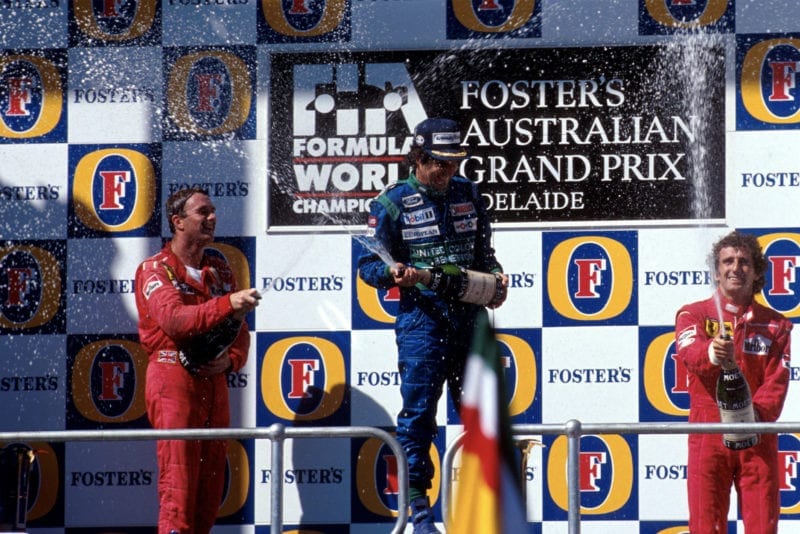
Piquet celebrates alongside Mansell and Alain Prost
Motorsport Images
On lap 62 the whole scene changed dramatically as Senna changed down for a relatively slow corner and found himself in neutral instead of second gear, and at racing speeds there is little chance of having time to try again. The result was that the McLaren went off into the barriers and Senna lost another assured victory. For the second race in succession Piquet was grinning to himself as he inherited the lead, but it was no foregone conclusion because Mansell was really flying, lapping in the low 1 min 19 sec bracket, and then the 1 min 18 sec bracket. As a final farewell to an unhappy relationship with his Ferrari team mate, from whom he thought he was going to learn so much, or so he said when Prost joined the team, Mansell flashed by him with ease on lap 73 and was hard after the Benetton. Right to the end of the 81 laps Mansell tried all he knew to get past Piquet, but the Brazilian wasn’t about to give way, and in a wonderful piece of true Grand Prix racing Piquet led Mansell over the line by 3.1 seconds, after the Ferrari had been alongside at one point in a desperate out braking manoeuvre that just failed to come off, but with no hard feelings or acrimony anywhere. It was a really healthy finish to the race and to the 1990 season.
Back in midseason someone in the paddock once said “Why don’t we share Championship points and the money between Senna and Prost before the races, then they can go home and we might get some good racing”. Not a bad idea. DSJ
